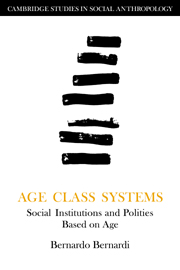Book contents
- Frontmatter
- Contents
- Translator's Preface
- Preface
- 1 Characteristics of age class systems
- 2 The anthropological study of age class systems
- 3 Legitimation and power in age class systems
- 4 The choice of ethnographic models
- 5 The initiation model
- 6 The initiation-transition model
- 7 The generational model
- 8 The residential model
- 9 The regimental model
- 10 The choreographic model
- 11 Women and age class systems
- 12 The ethnemic significance of the age class system
- 13 History and changes in age class systems
- Glossary
- References
- Index
6 - The initiation-transition model
Published online by Cambridge University Press: 29 September 2009
- Frontmatter
- Contents
- Translator's Preface
- Preface
- 1 Characteristics of age class systems
- 2 The anthropological study of age class systems
- 3 Legitimation and power in age class systems
- 4 The choice of ethnographic models
- 5 The initiation model
- 6 The initiation-transition model
- 7 The generational model
- 8 The residential model
- 9 The regimental model
- 10 The choreographic model
- 11 Women and age class systems
- 12 The ethnemic significance of the age class system
- 13 History and changes in age class systems
- Glossary
- References
- Index
Summary
Analysis of the initiation-transition model takes us from Africa to South America and, more precisely, to Brazil. The simple initiation model is characterized first by the value given to the initiation of youths and then by the permanence of class membership for all the members throughout the entire course of their successive promotions in the grade ladder. By contrast, in the initiation-transition model the permanence of the class is more nominal than actual, for once members have reached a certain grade they pursue other channels in seeking to augment their social standing. This is not, then, merely, a variant of the initiation model, but rather a different kind of primary polity, one that merits separate consideration.
In Brazil, the only part of South America where age class systems have been documented, the situation is now becoming, and in some cases has already become, so acculturated that it is no longer possible to directly observe the functioning of the local systems. What remain are vestiges that may be more or less striking. This is the case among the Sherente, whereas the Akwẽ-Shavante, related to them, still had a functioning system in the second half of this century. For this reason, in analyzing this model we focus on the Shavante system, making use of the most recent ethnographic sources (Giaccaria and Heide 1971; Maybury-Lewis 1974). Maybury-Lewis devotes the fourth chapter of his monograph to a description of the age set system.
- Type
- Chapter
- Information
- Age Class SystemsSocial Institutions and Polities Based on Age, pp. 62 - 72Publisher: Cambridge University PressPrint publication year: 1985

